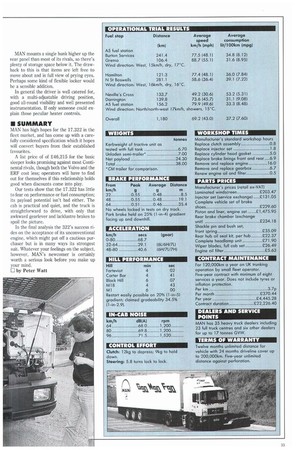ROADTEST
Page 34

Page 35

If you've noticed an error in this article please click here to report it so we can fix it.
MAN 17.322
impossible to quantify, but with the new spoiler kit on the MAN cab the artic certainly looked impressively aerodynamic.
Combine this with an engine whose specific fuel consumption is close to the best in its class at 190g/kWh and you have a recipe for good economy.
This was reflected in the 17.322's overall consumption of 37.21it/100km (7.6mpg), recorded at a competitive average speed of 49.2km/h (43.0mph), which puts the MAN up with the more fuel-efficient 38-tonners we have tested.
A closer look at the individual sections of our test route shows that it did particularly well over the A-roads and motorways of the final day — the 31.11it/1001cm (9.08mpg) obtained running down the Al to Darrington is a fine result — but it is noticeable that this high-geared truck couldn't extend its advantage over the severe gradients of the A68.
To some extent the hilly section mirrors the effect a heavy footed driver might have on fuel consumption. It is worth repeating that the fuel efficiency of the latest generation of low-revving diesels depends on having a well-trained driver behind the wheel.
• CAB COMFORT
The F90 cab might be a touch on the austere side for some tastes but this is, after all, a fleet machine, and its practical interior, sound control layout, solid construction and refinement are likely to impress potential purchasers more than superficial gloss. Although the engine hump interferes with cross-cab movement it doesn't prevent it and there's enough elbow and head room to make a sustained trip away a reasonably comfortable proposition. MAN mounts a single bunk higher up the rear panel than most of its rivals, so there's plenty of storage space below it. The drawback to this is that items are left free to move about and in full view of prying eyes. Perhaps some kind of flexible locker would be a sensible addition.
In general the driver is well catered for, with a multi-adjustable driving position, good all-round visibility and well presented instrumentation. If only someone could explain those peculiar heater controls.
• SUMMARY
MAN has high hopes for the 17.322 in the fleet market, and has come up with a carefully considered specification which it hopes will convert buyers from their established favourites.
A list price of of £46,215 for the basic sleeper looks promising against most Continental rivals, though both the Volvo and the ERF cost less; operators will have to find out for themselves if this relationship holds good when discounts come into play.
Our tests show that the 17.322 has little to fear on performance or fuel consumption; its payload potential isn't bad either. The cab is practical and quiet, and the truck is straightforward to drive, with only that awkward gearlever and lacklustre brakes to spoil the picture.
In the final analysis the 322's success rides on the acceptance of its unconventional engine, which might put off a cautious purchaser but is in many ways its strongest suit. Whatever your feelings on the subject, however, MAN's newcomer is certainly worth a serious look before you make up your mind.
0 by Peter Watt
























































































